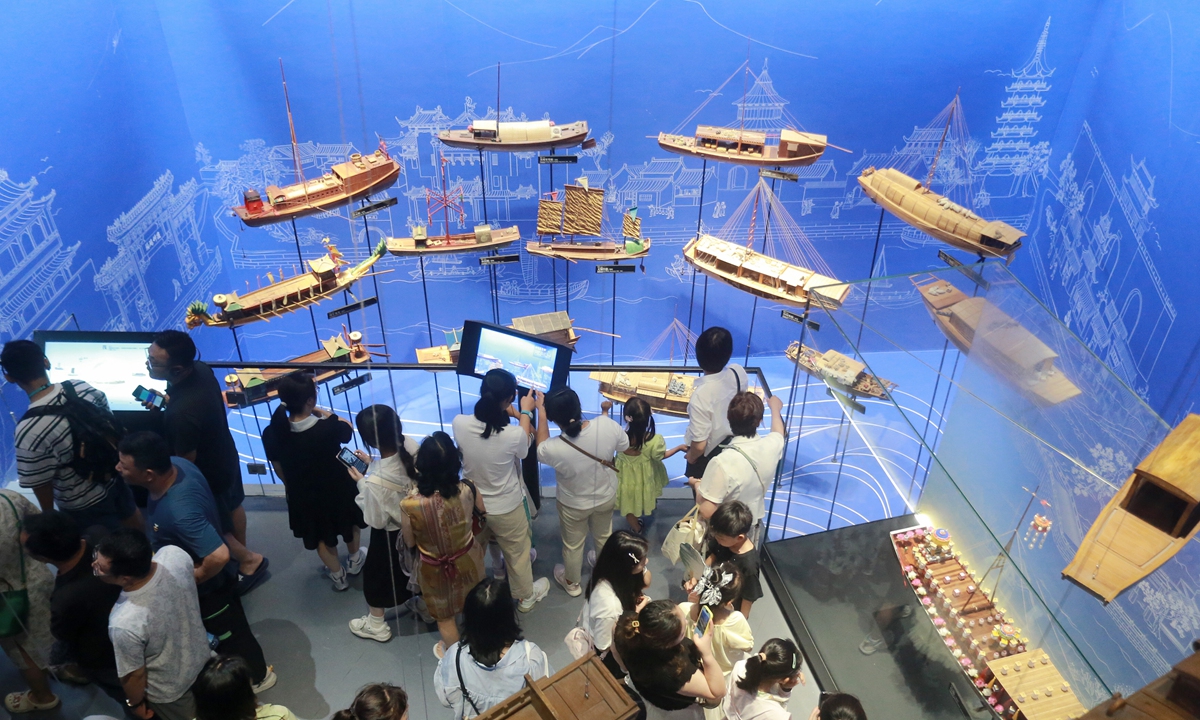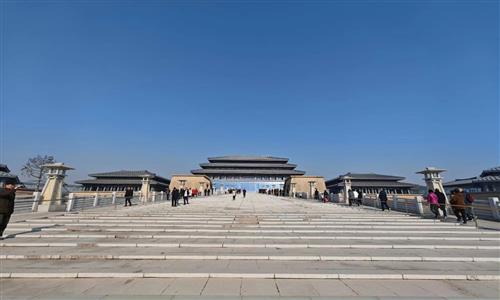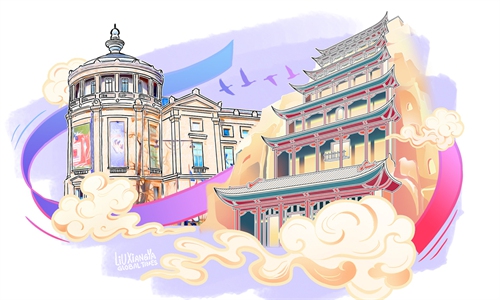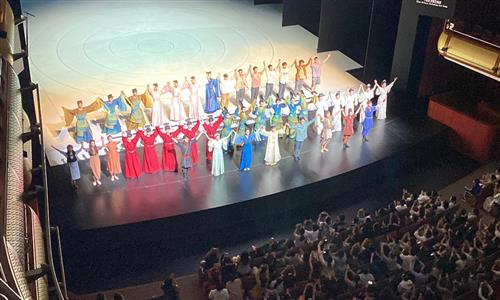ARTS / CULTURE & LEISURE
Surge in museum visits expected
Summer vacation, visa-free policy fuel popularity

Visitors at the China Grand Canal Museum in Yangzhou, East China's Jiangsu Province on July 2, 2024 Photo: VCG
With summer vacation on the horizon, a renewed interest in museums is sweeping across China. On Monday, the National Cultural Heritage Administration (NCHA) issued a notification outlining measures to enhance museum services during the 2024 summer season.
Key and popular museums are encouraged to extend opening hours, organize virtual exhibitions, education courses, and live streams, and offer mobile exhibits to better meet public demand, said the administration.
According to data released in 2023, China boasts 6,833 museums, with over 90 percent offering free admission. Statistics from the NCHA show that during the May Day holidays, museums across the country received a total of 50.54 million visitors, the highest number recorded for that period.
This surge in popularity is attributed to museums continuously enriching their educational programs, innovating interactive experiences, and developing cultural and creative products.
Museums are not only recorders of history but also serve as bridges connecting the past, present, and future, playing an important role in fostering cultural confidence. Every museum visit offers visitors an opportunity to appreciate the profound and enduring heritage of Chinese culture.
The summer vacation period will also see a variety of educational museum activities. With the break for students approaching, several museums in East China have launched educational tours with the theme "Tracing the Roots."
The Heyuan Dinosaur Museum, located in South China's Guangdong Province, has planned a series of education activities, such as the "I'm restoring fossils at the Heyuan Dinosaur Museum" public welfare research and study experience class. Activities such as dinosaur science classrooms are also being held in the museum.
The official website of the Palace Museum in Beijing has announced new fast reservation and ticket inspection measures for minor tour groups during the summer. These measures will be implemented from Tuesday to August 31.
"Since the reform and opening-up era and with the rise in comprehensive national strength, Chinese people have become increasingly proud of and confident in our cultural heritage. Their love for traditional culture is heartfelt, and appreciating cultural relics has become an effective way to express their feelings," Sun Jiashan, an associate researcher at the Central Academy of Culture and Tourism Administration, told the Global Times on Tuesday.
With China launching its visa-free policy, foreign nationals from certain countries can enjoy visa-free entry under the 72/144-hour transit policy. As the policy coverage expands, the influx of foreigners traveling to China becomes increasingly significant.
Take Xi'an, capital of Northwest China's Shaanxi Province, for instance. The ancient city, which witnessed the rise and fall of 13 dynasties, is considered the starting point of the ancient Silk Road. As seen on social media, historical landmarks and archaeological sites in the city, such as the Emperor Qinshihuang's Mausoleum Site Museum, home of the famous army of Terracotta Warriors from the Qin Dynasty (221BC-206BC), have been packed with foreign visitors.
Along a Tang Dynasty (618-907) themed block inspired by the 2019 Chinese historical drama The Longest Day in Chang'an, some foreign travelers enjoy taking photos with people dressed up in hanfu, while others try on these beautiful traditional clothing themselves.
As seen in videos shared online, at one Tang Dynasty themed restaurant, foreign dinners enjoy a wide selection of local dishes, as well as various performances such as song and dance shows with looks of amazement on their faces.
Many Chinese netizens have suggested that local authorities across the country should take this opportunity to showcase their region's own unique traditional culture to the world. This wave of "China travel" brought about by the country's visa-free policy could become a window for deepening understanding of Chinese culture. And museums, among the many tourist attractions, could play a crucial role to this end.
Take the ongoing Chinese Bridge Flying Tigers Summer Camp for American Youth for example. The 16-day camp, involving a total of 70 US students and teachers, is set to end on July 8.
The camp itinerary includes visits to Beijing and Southwest China's Yunnan Province. For many of the US students, this is their first visit to China. The students have visited many museums such as the Palace Museum and Liu Yongzhou Shadow Puppetry in Tengchong, Yunnan Province.
During their visit, they had the opportunity to experience traditional Chinese cultural activities, including making shadow puppets, playing traditional Chinese musical instruments and Chinese painting.
At an opera-themed museum in Taiyuan, North China's Shanxi Province, a group of Russian youth watched a Jin Opera (a traditional opera form native to Shanxi Province) performance about Guan Gong, the renowned Chinese general from the Han Dynasty (206BC-AD220).
To mark International Children's Day on June 1, the Opera Museum for Youth opened to the public on May 31. Through various exhibitions of photos, clothing, musical instruments and live performances, the museum aims to pass on the cultural heritage of traditional Chinese operas to the younger generation.
"Due to the internet, more and more young people from abroad are traveling to China. By visiting museums, they can quickly learn about China's outstanding traditional culture, and mainstream culture, while also having an evocative and lively experience," noted Sun.



